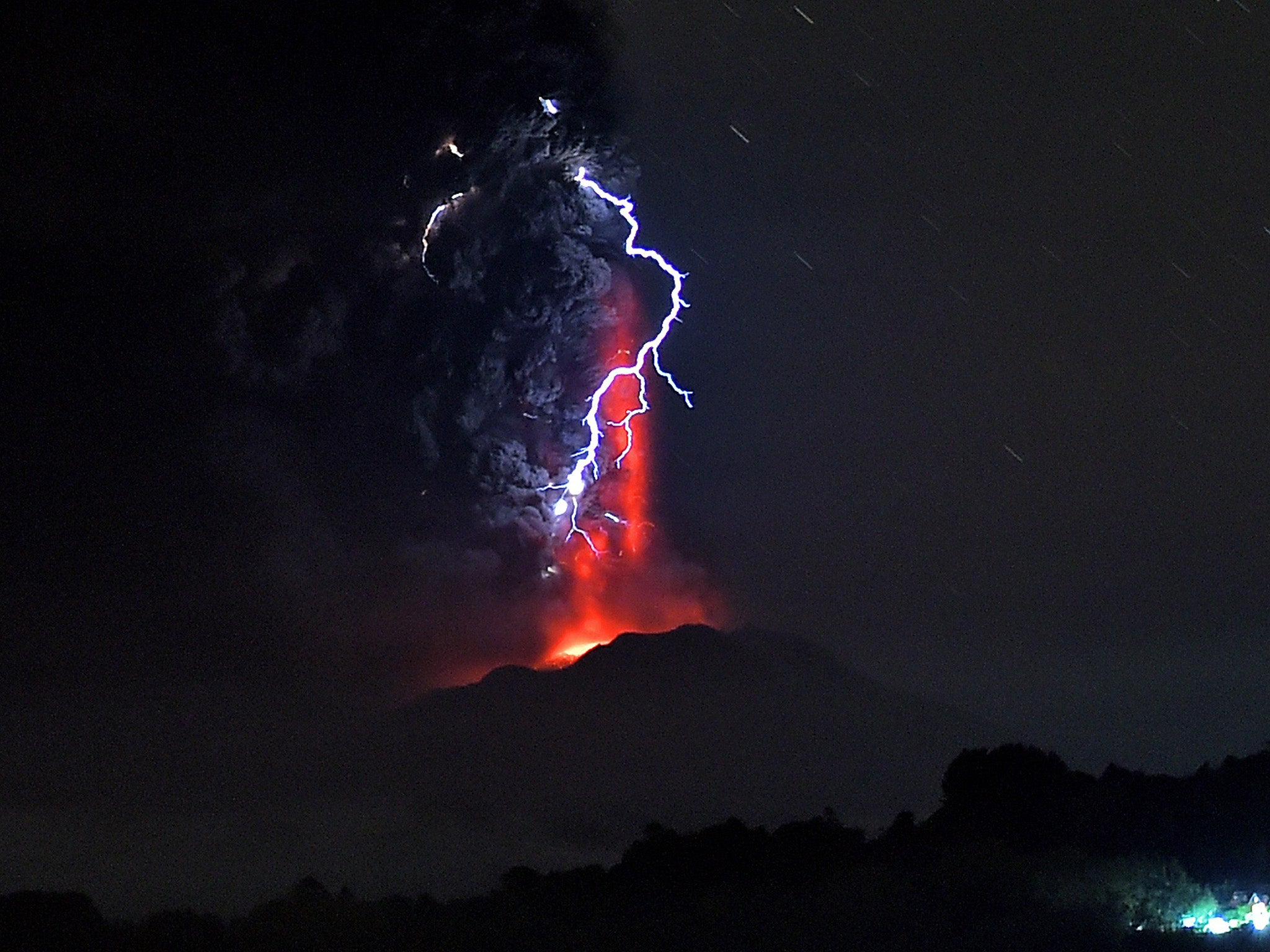Science roundup: How termites can improve cooling in buildings, and other stories
Fungi-infested marshmallows, mosquitoes and volcanic lightning; and other stories from around the world

Your support helps us to tell the story
From reproductive rights to climate change to Big Tech, The Independent is on the ground when the story is developing. Whether it's investigating the financials of Elon Musk's pro-Trump PAC or producing our latest documentary, 'The A Word', which shines a light on the American women fighting for reproductive rights, we know how important it is to parse out the facts from the messaging.
At such a critical moment in US history, we need reporters on the ground. Your donation allows us to keep sending journalists to speak to both sides of the story.
The Independent is trusted by Americans across the entire political spectrum. And unlike many other quality news outlets, we choose not to lock Americans out of our reporting and analysis with paywalls. We believe quality journalism should be available to everyone, paid for by those who can afford it.
Your support makes all the difference.Injecting marshmallow bunnies with fungi, for science
It’s science time in Candy Land. On Twitter last week, a scientist at West Virginia University in the US shared his latest experiment: sugar-coated marshmallow bunnies inoculated with a dozen kinds of fungi. Thousands of people are eager to see the results.
Welcome to the weird world in which mycologist Matthew Kasson is studying whether common fungi can survive or even thrive under extreme conditions – such as on the chemically preserved, water-deprived marshmallows sold in the US under the brand Peeps. He hopes to show how a simple, silly experiment can illuminate the basics of studying fungal biology and ecology.
“Given it’s the holiday season – of which Peeps are a part of – I thought it would be interesting to see if fungi could colonise these things that have a long shelf life,” Kasson said.
Peeps are a good substance for fungal research because they contain sugar and corn syrup, which some fungi love. But they also contain potassium sorbate, a preservative that prolongs shelf life and prohibits the growth of many moulds and yeasts. So Kasson bought two packages of yellow and pink peeps (with personal funds) and brought them to his lab.
He selected fungi from a stock of cultures he was growing for his daily work investigating their roles in forest pathology. The dozen candidates included fungi common in forests that love sugar, degrade wood, cause diseases in trees or are related to penicillin, which seems to tolerate potassium sorbate.
With a sterile scalpel, he sliced a vertical incision in each bunny’s belly and inserted fungal samples. He repeated this for all 12 fungi in pink and yellow Peeps. Twenty-four hours later, he added a drop of sterile water “directly into the incision wounds” of a random set of peeps to assist colonisation.
After two weeks, Kasson will bisect the subjects to search for signs of growth, such as mycelium or spores. When the experiment ends, he will isolate anything that took root, or try regrowing the fungal bits he put into the Peeps to demonstrate that the sweets didn’t kill it.
“We will then autoclave them with the rest of the hazardous material,” Kasson said. “There will be no consumption.”

Love at first bite: how mosquitoes sniff your sweat
It’s actually very difficult to attract mosquitoes. It may not feel that way on a warm and sticky summer night. But every time a mosquito sneaks up to an animal thousands of times its size to feed, it is trying to pull off something extremely dangerous, said Matthew DeGennaro, a mosquito geneticist and professor at Florida International University. The right cues – a whiff of exhaled carbon dioxide, warmth, a bit of body odour, and other mysterious elements of animal smell – have to be there, or mosquitoes won’t take the risk.
To design traps that could lure mosquitoes, scientists would love to know how they are picking up these cues. In a paper published in Current Biology, DeGennaro and colleagues report that they have unravelled part of the mystery. They identified a receptor in the mosquito’s antennae that allows the insects to detect lactic acid, a substance from human sweat that the bugs find very attractive.
The work began years ago when DeGennaro, then working in the lab of Leslie Vosshall at Rockefeller University, identified another odour receptor that mosquitoes used to home in on prey. However, even with that receptor destroyed, mosquitoes could still find humans as long as carbon dioxide was floating around. That suggested that other receptors, presumably ones that detect carbon dioxide, were compensating for the loss.
DeGennaro and his colleagues went in search of these other players. The researchers put mosquitoes that had been engineered to lack a receptor called Ir8a into chambers where they were exposed to combinations of carbon dioxide, lactic acid, warm temperatures and the arms of human volunteers.
“We just did a simple behavioural test to whether they could respond to lactic acid,” said DeGennaro. “And they couldn’t.”
The knowledge could eventually lead to repellents that hamper the normal functioning of Ir8a, or help construct effective traps, Gennaro said.
New, effective strategies for mosquito control that can be used in combination with each other are crucial, DeGennaro said. The use of an insecticide alone, for instance, encourages the development of insects that are resistant. But if traps, chemicals to kill larvae and other tools are used all at once, it’s possible to have more success.

Saturn’s rings are sculpted by mini-moons
Saturn has more than 60 moons but a handful of them do more than spangle the planet’s skies.
Snuggled close to Saturn, these innermost moons are small – Epimetheus, one of the largest, stretches just 72 miles across. But they are hefty enough to help sculpt Saturn’s rings. Orbiting at the edges of some of the planet’s main rings, or in gaps between them, these shepherd moons wield enough gravity to herd icy ring particles into place. Some, like Atlas, tend the bangles by pruning and neatening their edges. Others, like Pan and Daphnis, mow lanes between the rings.
“These moons kind of sweep out cavities within the rings,” said Bonnie Buratti of Nasa, who described the mini-moons in a study published in Science.
But the rings sculpt the moons, too, coating them with colourful mounds of ice and crafting some unusual shapes.
“They’re quite different than the rest of the moons,” said co-author Carly Howett of the Southwest Research Institute in Texas. “Some of them look absolutely crazy.”
After more than a decade in orbit around Saturn, Nasa’s Cassini spacecraft plunged through the planet’s atmosphere in September 2017. Before it vaporised, the probe completed a series of ring-grazing loops that included five close fly-bys of Atlas, Daphnis, Epimetheus, Pan and Pandora. Now, using Cassini’s observations of shape, colour and composition, scientists can guess at the moons’ origins – and are working on figuring out why some of them look so utterly different from the space potato-shape of most small bodies.
Cracked and cratered, 17-mile-wide Pan is wearing a narrow, knife-edge fringe around its equator, while 30-mile-wide Atlas is smooth and swaddled in a skirt that’s so voluminous it mostly hides the moon’s bulbous core. Based on Cassini’s observations, the team determined that these skirts are made from ring particles that collide with and stick to the moons, rather than from shifting terrain.
“Neither of these moons is actually orbiting in a cloud of ring material right now, so it wasn’t necessarily obvious that the equatorial ridges come from accreted ring material,” said Matthew Tiscareno of the SETI Institute, who was not involved in the study. He said more work was needed to explain the differences between the two moons.

Why lightning erupts in volcanoes
As plumes of ash rise from a volcano, volcanic lightning sometimes erupts in its clouds.
Generally, it’s assumed that jostling ash particles build up huge electrical imbalances that can only be neutralised by supercharged bolts. But something else may contribute to the electrification of volcanic plumes.
By sending balloon-raised electricity-detecting instruments over Sicily’s hyperactive Stromboli volcano, scientists discovered that even volcanic clouds that lack ash contain substantial amounts of charge. The source of this phantom electrification could be the decay of volcanic radon, an odourless and colourless radioactive compound.
A similar process may occur above radon-emitting volcanoes around the world, said Karen Aplin, a physicist at the University of Bristol and a co-author of the study published in Geophysical Research Letters. If radon-driven electrification influences the behaviour and lifetime of volcanic ash plumes – the very same that can down planes, bury cities and suffocate farms – then understanding the gas’s role could help us be better prepared.
Stromboli – which has spectacular lava fountains matched only by its extremely gassy outbursts – was the perfect place for the experiment.
It’s well-established that as radon decays, it releases charged particles that collide with compounds in the air, ionising them. This, the researchers suspect, was electrifying the ash-free plume.
“We can’t be sure that it is radon which is generating the charge in such plumes without many further measurements,” said lead author Keri Nicoll, an atmospheric scientist at the universities of Reading and Bath. But she added that it’s very likely that “there are no other known charge generation mechanisms that can explain our observations.”
While it contributes, radon is probably not the sole arbiter of volcanic lightning. It certainly generates charge, but as Aplin explained, “it’s unlikely that the radon mechanism alone could ever be strong enough to generate volcanic lightning without the help of ash.”
Cassandra Smith, an expert on volcanic lightning at the University of South Florida who was not involved in the study, agrees. She pointed out that no lightning was generated by that radon-rich, ash-free plume over Stromboli. She has also seen lightning appear during eruptions at the Sakurajima volcano that feature extremely small amounts of ash.

What termites can teach us about cooling our buildings
In the capital of Zimbabwe, a building called Eastgate Centre holds nearly 350,000 sq ft of office space and shops. It uses 90 per cent less energy than a similar-sized building next door.
What’s the secret? Termites. In the 1990s, Mick Pearce, the building’s architect, took his inspiration from mounds built by fungus-farming termites he saw on a nature show. The insects created their own air conditioning systems that circulated hot and cool air between the mound and the outside.
As architects and builders seek new and improved ways to cool buildings without using more energy in a warming world, a study of another type of termite mound suggests that Pearce won’t be the last human to take design tips from these cockroach cousins.
“We think humans are the best designers, but this is not really true,” said study author Kamaljit Singh, an engineer at Imperial College London. “We can learn from small animals.”
Singh and his colleagues used high-resolution scanning technology and computer and physical simulations to examine the microscopic structure of the external walls of African termite nests. In slabs that look solid to the naked eye, the team found a network of tiny, interconnected pores. Through principles of basic physics, these pores regulate ventilation, humidity and possibly temperature, within the mound and nest. These natural structures may offer inspiration for engineers and builders, emphasising how comfort can be achieved through structure alone.
Scott Turner, a physiologist who was not involved in the study, said Singh’s research revealed how these pores help manage gas flow and drainage.
“If you look at the physics of gas exchange in the lung, it’s very much the same way as the termite mound is organised,” Turner said.
Singh and his colleagues, whose study was published in Science Advances, hope future studies of nests from other termite species will reveal general design principles that can be scaled up for humans. And as Eastgate Centre shows, buildings inspired by termites don’t have to look like termites built them.
“There is a danger to see beautiful forms and shapes in nature and simply copy them,” said Pearce. “We’re not copying forms. We’re copying the process that made the form.”
© New York Times
Join our commenting forum
Join thought-provoking conversations, follow other Independent readers and see their replies
Comments